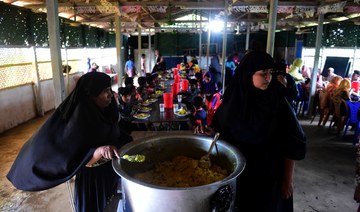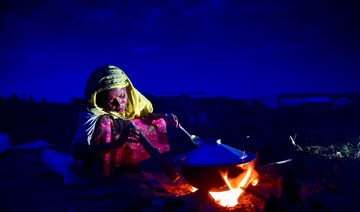NEW DELHI: As he teaches his students how to write the rounded characters of a script resembling Arabic, Mohammad Ismail is on a mission to reclaim his native tongue, history and Rohingya identity — one letter at a time.
Few Rohingya know how to read and write their own language as their community has for decades faced attempts of cultural annihilation in their homeland Myanmar.
When government security forces systematically targeted the minority Rohingya Muslim population and forced nearly 1 million of them to flee to neighboring Bangladesh in 2017, it was the culmination of this abuse.
But attempts at removing the Rohingya from Myanmar’s public space have been made since 1960s, when broadcasters were barred from using their language. It would not be taught at schools either.
The language is an Indo-Aryan tongue related to Bengali-Assamese. It was first written with a version of the Arabic alphabet during the 19th century and later, when the British colonized today’s Myanmar, English and Urdu letters were used.
Only in the 1980s, a suitable phonetic script was developed by Rohingya scholar Mohammad Hanif.
Known as Hanifi Rohingya, the alphabet is based on Arabic letters with adaptations to accommodate tonality, nasalization and vowels. In 2018, it was standardized by the Unicode Consortium, which gave it a new lease of life, allowing the Rohingya to send digital messages in their own alphabet.
It was then that Ismail, like many other Rohingya, took online courses to finally read and write in their mother tongue.
“At the age of 29, I learnt the script of my language which I have been speaking since my birth,” he told Arab News.
“We were never taught in that language. The authorities there (in Myanmar) did not allow any kind of teaching in the Rohingya language.”
Ismail’s family fled Myanmar in 2007. They spent six years in Bangladesh and then found a way to move to India, joining a 40,000-member Rohingya community.
He now lives in Faridabad, a district adjacent to Delhi, where he is a preacher and — since he mastered the Hanifi writing system — also a Rohingya tutor.
“It’s my life’s mission to teach my fellow Rohingya the script of the language, so that our identity and history are preserved,” Ismail said.
“This is quite empowering for us and gives us a sense of rootedness. We would translate books and other educational texts in our language to educate our people.”
In his poor, slum neighborhood, he has built a small makeshift pavilion where classes take place. Besides the Rohingya language, he also teaches Arabic and Urdu.
“Arabic is important for the community people to know because they have to learn the Qur’an,” he said.
“I feel it’s my duty to educate Rohingya kids and adults so that they know about themselves and the world.”
He can be sure that his mission will be taken up by his students.
One of them, Mariyan, has been studying with Ismail for over a month.
“I come every morning for two hours to learn the language,” the 10-year-old told Arab News. “My mother also wants to learn. When I learn the language, I can teach her.”
Her classmate, Aisha Siddiq, is also learning the script for the first time. Until now, like most Rohingya children, she has only known Rohingya oral tradition, its folktales, folk songs and lullabies.
“I hope that despite challenges I will be able to learn it in (a) few months so that I can gradually read books in my language,” she said.
“When I grow up, I would like to write the story of the struggle (of) my family and community in my own language.”
For elder Rohingya, the reclaimed language is also a new means of survival for the community.
“The authorities in Myanmar want to obliterate our linguistic footprints so that they could deny our existence” said Sabber Kyaw Min, 34, the founder of the Rohingya Human Rights Initiative, an NGO in New Delhi.
He has been learning how to write in his mother tongue for the past three months.
“For me, my language means telling my own story,” Sabber said. “Language reflects the community’s history, culture and background.”













